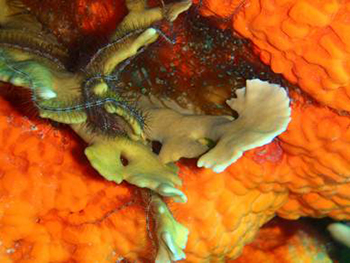Fire Coral
Millepora alcicornis

Taxonomy
Kingdom Animalia
Phylum Cnidaria
Class Hydrozoa
Order Capitata
Family Milleporidae
Life History
Habitat
Fire corals are most commonly found in shallow reefs where an optimum level of sunlight is available and a variance exists in the flow of water. In regions with a high and strong currant, Fire corals may thrive in abundance and some also exist on reef faces or the edges of reefs. They are seen mainly in the warmer regions of the oceans (Shedd, 2011). However, fire corals are absent from the coral reefs of Hawaii (Borneman, 2011).
Resources
Fire corals feed mainly on zooplankton or phytoplankton by sifting the water with their tentacles, once the animal/plant is detected it is shot down by nematocysts and covered with mucus before being delivered to the mouth of the coral (Shedd, 2011).
Reproduction
The Fire coral goes through sexual reproduction by alternation of generations, when conditions are right the polyp releases a medusa, the free flowing form that releases its eggs into the water stream which another male medusa comes to fertilize and a planula is formed. A planula is bean shaped and simply swims around in the water column until it finds a reef where it grows back into a polyp that settles on a hard surface. The polyp then continues to grow asexually and reproduces many duplicates of itself to form a colony of fire coral (Shedd, 2011).
Behavior
The Fire coral is actually not a coral, but rather a hydrozoa undergoing two different life forms. It can take on many different shapes depending on its environment. In places with a light current, the coral might grow in long thin strands that form a lattice, whereas in an area with mildly strong currents, the choral will grow thick branches or columns. In extremely strong water currents, the coral will grow to form a thin crust. The coral also carries on a symbiotic relationship with zooxanthellae, an algae that lives in the coral providing it food while feeding on the Fire coral waste and retaining shelter. Unlike most corals, Fire corals have tiny polyps that are almost microscopic and there are two specialized polyps, one with nematocysts released for protection as a defense mechanism and the other for sexual reproduction. Fire corals are also hollow tubes that store oxygen to offset any organism that bumps into it (Shedd, 2011).
Anatomy
Fire coral have a rather smooth skeleton despite the texturized appearance. Their skeleton has a hollow structure that incases the living polyps until they are ready to be released. Along the surface, are many pores including the gastropores that include the short, plump feeding polyps; dactylopores that contain the stinging polyps; and ampullae, which release the polyps specialized in sexual reproduction. These polyps only survive a few hours but only die after releasing eggs/sperm (Borneman, 2011).
Recent Research
In 2003, Banaszak and several of his colleagues, experimented with two different colonies of Fire coral in the Mexican Caribbean. Both colonies were exposed to different levels of light, with one having 5.9 times lower the light available to the other colony. At a time when the water temperature rose 1.5 degrees above average, the corals in the higher amount of light were bleached while the coral in the lesser light showed no affect. The difference in the two coral colonies proves that a raise in temperature alone will not bleach Fire corals, but will need the aid of higher availability of light to do so (Banaszak et al, 2003).
Personal Interest
Fire coral has a very interesting name as well as characteristics. I became interested in it just based on the name and it’s facts haven’t failed to hold my interest. Fire coral is not extremely attractive but it is attractive and alluring but will sting you upon touching it. It works together in a colony by tripping fish in their path and making them fall on other fire corals around it.
References
Banaszak AT, Ayala-Schiaffino BN, Rodriquez-Roman A, Enriquez S, and Iglesias-Prieto R. 2003. Response of Millepora alcicornis (Milleporina: Milleporidae) to two bleaching events at Puerto Morelos reef, Mexican Caribbean. Rev. Biol. Trop., 51, 4:57.
Borneman, Eric. "Venomous Corals: The Fire Corals by Eric Borneman - Reefkeeping.com." Reefkeeping Blog. Web. 27 May 2011.< http://reefkeeping.com/issues/2002-11/eb/index.php>.
"Shedd Aquarium." Shedd Aquarium - Chicago | Home. Web. 26 May 2011. <http://sea.sheddaquarium.org/sea/fact_sheets.asp?id=93>.
Links
Interesting facts: http://therightblue.com/2007/11/fire-coral-look-but-do-not-touch.html